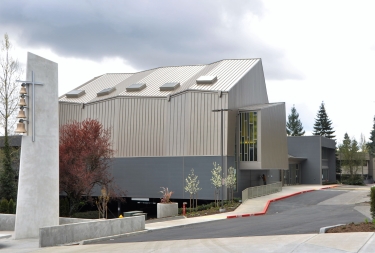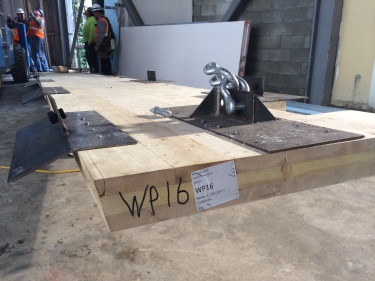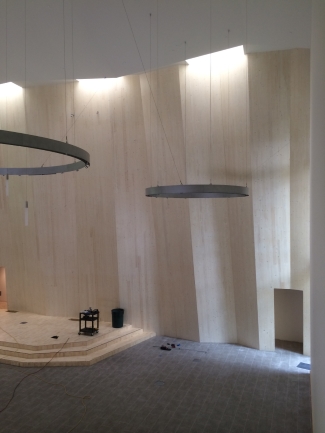|
Subscribe / Renew |
|
|
Contact Us |
|
| ► Subscribe to our Free Weekly Newsletter | |
| home | Welcome, sign in or click here to subscribe. | login |
News
| |

April 28, 2016
Old office building becomes worship space for relocated Bellevue church
Journal Staff Reporter
When the First Congregational Church, Bellevue opened the doors to its first home in 1901, it was a little white church in the city's downtown.
In 1952 the building was razed to make way for a new church at 752 108th Ave. N.E. But over the years the second building began showing its age and just didn't meet the church's needs.
With rising land values in mind, the church in 2014 sold the 1.6-acre site to Plus Investment USA for $30 million.
But the church needed to find another downtown site in a hot real estate market. It made an unusual selection: the 49,000-square-foot 1970s Star Plaza office building at 11061 N.E. Second St., less than a half-mile from its former home.
The building was transformed with a design by atelierjones into an inspirational space.
“It's more than great,” Otis Gillaspie, co-chair of the design advisory committee for the new building, said. “I don't know where to start.”
The highlight of the project is a 39-foot-tall wall in the newly created 5,000-square-foot sanctuary that is made of angled, undulating cross-laminated timber panels. The panels are lit by skylights and tall windows.
The CLT wall was proposed by Susan Jones of atelierjones, whose Seattle firm has researched CLT use since 2010, and whose students in a University of Washington design studio studied the use of CLT in sacred places. Jones also designed and had built a house for herself that is constructed of cross-laminated timber.
Still, she said, it was not a easy decision for the church to go with CLT. It is a new technology, especially to the U.S., and CLT had rarely been used in churches.
“It was a big risk for them,” Jones said. “It was a very bold and brave move.”
The CLT panels are 8 feet wide by 40 feet high, and 4 inches thick. They were cut with a CNC system by CLT fabricator Structurlam in British Columbia to create the undulating angles.
The 17 panels form the sanctuary's back wall and angle into the space from the top. The panels are supported off of steel columns by a series of steel brackets screwed into the rear of the panels.
Jones said she learned a lot from the contractor, Goudy Construction. Typically a 40-foot crane would hoist the panels into place using a system in which a Rampa screw is put in the wood and a loop is put around the screw. The crane then hooks onto the loop, the CLT is swung into place and the screw is removed, Jones said.
In this case, Goudy wanted to place the panels after the sanctuary shell was closed in to keep the panels out of the elements. Therefore, a crane could not be used.
So, after the shell was finished, Goudy put the panels into place using winches, pulleys and scissor lifts, Jones said.
“It's a reminder of how simple and dumb all of this technology is, and we fall into the trap of making it too complicated,” she said.
Gillaspie also complimented Goudy and Richard Leider of Trinity Real Estate, the owner's representative. Rob Larson was also on the Trinity team.
Other project team members are DCI Engineering (civil and structural), Arup (acoustical design), Lauchlin R. Bethune Associates (landscape architect), Blanca Lighting Design, University of Washington Integrated Design Lab (daylighting consultant) and Burton Tidwell (organ consultant).
The church was founded in 1896, and now has about 500 members.
It spent $15 million of the money it got from Plus Investment to buy Star Plaza, and put $3 million in an endowment for future church use, according to Gillaspie. It used $10 million to covert the office building.
Gillaspie said the former church building had security issues because of the many external doors, and the layout was not configured for First Congregational's needs. The 1950s wood-frame building would have cost too much to reconfigure and bring to current standards, he said.
Also Star Plaza has an atrium, which the church wanted as a gathering area for people before and after services and to welcome the community.
The newly transformed church building also has offices, meeting rooms, a nursery, fireplace lounge, chapel, music and education suites, the sanctuary and space that is rented to Catholic Community Services and The Sophia Way, which works to help end homelessness for single adult women in King County.
Gillaspie said Jones initially wanted to use CLT as a structural element in the sanctuary walls, ceiling and roof, but the church felt it would be better, from an engineering perspective, to use the material in only one wall.
That's because of the cost and because the church didn't know of any other CLT structure that was that large and self-supporting, he said.
Gillaspie said the church is happy with the CLT wall that was created.
“I think everybody loves it,” he said. “The design is sort of a vertical zigzag, so it's not just a straight wall. It also tilts a bit.”
Jones said cross-laminated timber sequesters carbon at high rates relative to other building materials such as concrete and steel. This is important because absorbing carbon from the atmosphere helps to address climate change. Also, she said, the trees that CLT is made from absorb carbon. If they are harvested from a sustainably managed forest you get a “win-win.”
Gillaspie said the sanctuary delivers a sense of awe, and the entire church “turned out just the way we wanted it.”
Church officials had pondered for years their facilities needs. They considered whether to renovate the old building, develop the site, co-develop or sell. They hired the Seneca Group to help.
Gillaspie said First Congregational made the right move.
“Now we want to use the building in the most productive way to meet the church's mission,” he said.
Lynn Porter can be
reached by email or by phone
at (206) 622-8272.
Previous columns:
- Local Rosie the Riveter tells her story of building Boeing B-17s during WWII, 04-21-2016
- Seattle's history and hills make life interesting for shoring contractors, 04-14-2016
- What you need to know about progress payments, 04-07-2016
- Next for drones? Helping design, build and sell projects, 03-31-2016
- Get ready for 80% hike in OSHA fines, 03-24-2016
- These builders limit their tools: Legos only, 03-17-2016
- Bend bakery building's roots are an iron foundry, 03-10-2016
- Why are there still so few women in construction?, 03-03-2016





